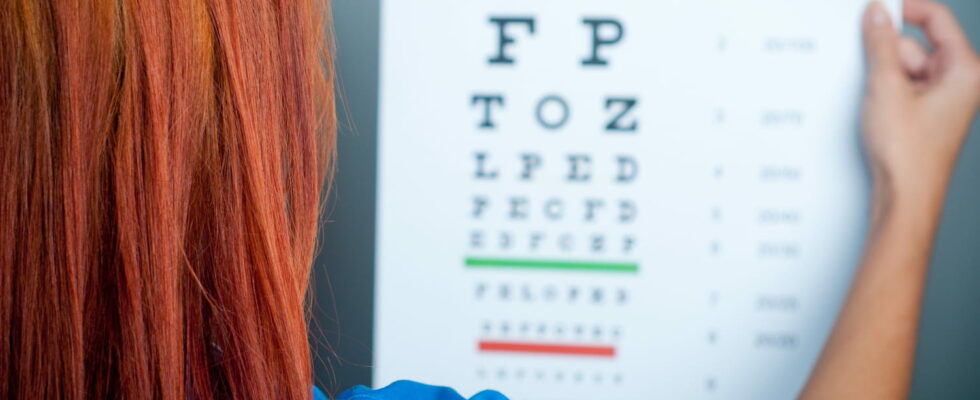Most people start to notice changes in their vision in their 40s.
Loss of vision is a natural phenomenon that occurs with age. “Most people start to notice changes in their eyesight in their 40s. However, vision decline can vary from person to person depending on various factors such as genetics, lifestyle habits , and pre-existing medical conditions” explains Dr. Louis Hoffart, ophthalmologist at the Monticelli-Vélodrome clinic (Ramsay Santé) in Marseille.
Do you move objects back to see them better?
One of the first symptoms is presbyopia. “It is a vision disorder, caused by the natural aging of the eye, which usually manifests itself in difficulty seeing up close and focusing, which can make reading and d ‘other more difficult activities nearby’, explains the expert. “As a result, people with presbyopia may need to hold objects at a farther distance to see them clearly, and they may have difficulty reading up close, working on a computer, or performing other tasks that require close vision. They also need more light to see.” It is important to consult an ophthalmologist for an overall assessment. The specialist can then prescribe reading glasses or multifocal contact lenses or even suggest laser surgery.
Dry and red eyes at the end of the day?
Screen disease or dry eye syndrome is an increasingly common eye condition, mainly due to prolonged exposure to computer screens, mobile phones, tablets, etc. “When you stare at a screen for long periods of time, you tend to blink less often, which can lead to excessive tear film evaporation and cause dry eye symptoms.”continues Dr. Hoffart. “The eyes may be dry, irritated, red at the end of the day, sensitive to light or burn. Vision may become blurred, especially at the end of the day. At the same time, the composition of the tears will change and become of poorer quality. To alleviate these symptoms, it is recommended to take regular breaks while using screens, blink frequently to moisten the ocular surface, and use artificial tears or lubricating eye drops if necessary.” It is also important to properly adjust the brightness and contrast of your screens to reduce eye strain.
Having trouble seeing car headlights?
From the age of 60, cataract problems can appear. “Caractar develops when the crystalline lens, the natural lens of the eye, becomes cloudy”explains Professor Antoine Rousseau, hospital practitioner in the ophthalmology department of the National Hospital of 15-20 in Paris. “The lens is normally clear and transparent, but with age (around 70-75 years), it can become opaque, leading to blurred or blurred vision, increased sensitivity to light (decreased contrast), impairment color vision and halos around light sources (car headlights for example).” Cataracts are treated surgically, usually around age 70. “The operation (which lasts around ten minutes) consists of removing the cloudy lens and replacing it with an artificial implant adapted to the needs of each patient, which will also correct vision. This can thus alleviate the need to wear corrective glasses .” This procedure is generally safe, effective, and better managed. “Most cataract surgeries are performed on an outpatient basis and require only local anesthesia.” Regular eye exams can help detect early signs of cataracts and take steps to treat the condition before it causes significant vision deterioration.
A spot in the middle of the vision?
Another, much more bothersome factor is age-related macular degeneration (AMD), which usually develops in people over the age of 50. “It is the leading cause of blindness in industrialized countries after age 65”, continues Dr. Hoffart. It’s about a progressive disease that affects the macula, the central part of the retina, where the photoreceptors are located. Its role is to evacuate waste from the retina. “It is characterized in particular by a dark spot in the center of vision, a distortion of straight lines or a reduction in vision. The macula is responsible for central vision and detailed vision, which is essential for activities like reading, driving, and recognizing faces. “The earlier the treatment, the better,” adds Professor Antoine Rousseau. There is little treatment for this disease, especially in the dry form, which is also the most common. “For the wet form, also called exudative or neovascular AMD, and which is a more advanced form of the disease, we can do intravitreal injections of anti-VEGF (vascular endothelial growth factor)”, recommends Dr. Hoffart. Painless, they are performed directly in the vitreous of the eye to block the growth of abnormal blood vessels and reduce fluid leakage into the retina. “This helps stabilize the patient’s vision. Without treatment, wet AMD can lead to severe vision loss.”
Severe eye pain? (it’s an emergency)
Finally, glaucoma is a disease that damages the optic nerve and is often associated with increased intraocular pressure. “It can lead to progressive loss of visual field and, in severe and untreated cases, permanent blindness. It affects around 5% of those over 50 and 10% of those over 75”, recalls Professor Rousseau. Glaucoma can progress without obvious symptoms until permanent damage is already present. “This is why regular eye exams are essential to detect glaucoma early and begin appropriate treatment to prevent significant vision loss.”, insists Dr. Hoffart. There are several types of glaucoma. “The most common is open-angle glaucoma, which develops slowly and often without obvious symptoms initially. Closed-angle glaucoma is less common but can be more sudden and cause severe eye pain, blurred vision, halos around lights and nausea.” This is an absolute emergency.
Eye drops are the first-line treatment for most cases of glaucoma. They are generally administered one to several times per day and work by decreasing the production of intraocular fluid or increasing its drainage. “Different types of eye drops may include beta blockers, adrenergic agonists, prostaglandin analogues and carbonic anhydrase inhibitors”, concludes Dr. Hoffart. If medical and laser treatments are not effective in controlling intraocular pressure, surgery may be recommended to create a new passage for intraocular fluid to reduce the pressure.
